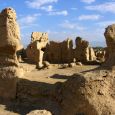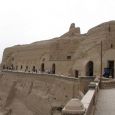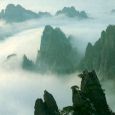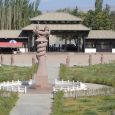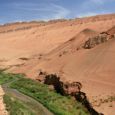Xinjiang
Advertisement
By Air
At present Turpan does not have its own airport, but visitors can use the Urumqi International Airport (URC). It is about 230 kilometers (142.9 miles) from the airport to Turpan city center and it takes only 2 hours' driving by expressway. There are 99 domestic services and 14 international services for 60 destination cities, such as Beijing, Shanghai, Xian, Guangzhou, Tashkent, Novosibirsk, Moscow and Islamabad. Turpan Airport is under construction.
By Train
Turpan Railway Station is located in Daheyan County, about 50 kilometers from the city center. Although it is a bit far from the city center, the traffic condition is good as the city buses and taxis are all available for you. The buses leave for Turpan city center every 30 minutes from 07:00 to 20:00 every day. The transport lines in Turpan extend in all directions. In the railway station, there are frequent trains coming and going each day between Turpan and other cities in Xinjiang Province, such as Urumqi, Hotan, Kashgar and Korla. Apart from that, there are trains to and from many big cities of China, including Beijing, Shanghai, Xian, Jinan, Chongqing and Zhengzhou.
By Bus
Like other middle cities in Urumqi, Turpan is not a city with high population density. So it is not very crowded when taking a city-bus and it is easy for you to find a seat. There are eight city bus routes in Turpan which can take you to different directions of the city.
Jiaohe
2200 years ago Jiaohe, 10km/6mi west of Turpan, was the capital of the Cheshi kingdom. After the 10th C it declined rapidly, and in the 14th C was razed to the ground by Genghis Khan's armies.
The Jiaohe site (Jiaohe Yizhi) measures 1km/1100yd from north to south and 300m/330yd from east to west. Remains from the Tang period (618-907) include a number of roofless houses, a large but collapsed temple and several roads leading to a main street.
Thousand Buddha Caves of Bezeklik
The best known are undoubtedly those at Bezeklik (some 50km/30mi northeast of Turpan), a collection of retreats once inhabited by Buddhist monks. Many of the important wall-paintings, a testimony to the heyday of Chinese Buddhism, were discovered by European archaeologists, many of them German, prior to the First World War.
In all visitors can see 57 caves, all numbered, which contain fragments of frescos from the 6th to the 14th C portraying Buddhist themes.
In Cave No. 39 can be seen a group of mourners accompanied by thirteen disciples of Buddha.The north wall of Cave No. 37 shows a painting of a bodhisattva, dressed in red and with blue eyes and a long, straight nose. The explanatory inscriptions are almost all in Chinese and Uigur; this suggests that at this time the cultures of China and Asia Minor complemented and influenced one another.At the approach to the Bezeklik Caves is a mini leisure park where the history of the Silk Road is vividly presented.
Aydingkol Lake
Aydingkol Lake (Aiding Hu in Chinese) gets its name from the Uigur word for the moon. The name is inspired by the glitter that this evaporating, muddy lake's salt deposit>Aydingkol Lake ,turpan gives off under the Turpan sun. This lake is the lowest lake in China and the second lowest lake in the world (second only to the Dead Sea) at 154m below sea level.
Located 50km south of Turpan, the total area of the lake is around 22 square km. The water is not very deep at an average of 0.8m, and sometimes large parts of the lake dry up. Literally nothing lives here as the salt makes for a harsh environment.
Astana Graves
To the northwest of the Gaochang Ruins lie the Astana Graves (Asitana Gumuqun), where the dead of Gaochang were buried. The ancient tombs are clearly zonedAstana Graves ,turpan according to families and castes with natural stones. The burial area is large and stretches 5 km from east to west and 2 km from north to south. Unfortunately, todayonly a few of the tombs are open to tourists.
The typical Astana tomb has a short flight of steps leading down into the tomb. The burial chambers of the tombs generally have low ceilings (about 2 meters high) and a total area of about 4 square meters. The two of the three graves open to the public have paintings of either the deceased or of birds, while the third has two well-preserved corpses on display!!
Flaming Mountains
The Flaming Mountains (Huo Yan Shan), are so named because in theFlaming Mountains,turpan evenings the red clay mountains reflect the heat and glow of the desert and seem to burn.¡¡Situated on the northern edge of the Turpan basin, and stretching over 100 km long and 10km wide, this is an intensely hot part of the desert with not a single blade of grass to be seen for miles. In the severe heat of July, the mountains seem to be on fire in the burning sun and become a purplish-brown color. Hot steam rises upwards from the burning cliffs and it is no surprise that this is where the hottest temperatures in China ever, were recorded
March - June


